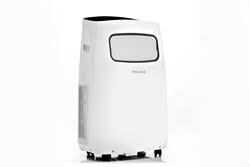It could be time to switch to an AC if a cooling fan isn’t quite meeting your home’s demands. Although window air conditioners may effectively chill a room while taking up less floor area, a portable air conditioner’s convenience and mobility are unmatched. When choosing between window and portable ACs, you must consider if a window unit is even practical because some are incompatible with specific window forms and home designs or are only permitted in specific types of structures.
Since 2020, the Menards Portable Air Conditioner Institute has been evaluating portable air conditioners, selecting the top models available and subjecting them to rigorous testing. When we assess ACs, we look at their ease of installation, their simplicity of use, and foremost, the effectiveness of cooling a place. We also regularly update our market research, noting changes to key performance indicators and new features while comparing testing results of older models to the most recent models from manufacturers.
When and when you need cooling, a portable air conditioner provides flexible, handy cooling. The portable AC units from Frigidaire are excellent for cooling down a room of your choosing in warm weather and come with caster wheels for easy mobility. For instance, you may easily chill your area that gets the most use during the day and then transfer the unit to your bedroom at night. A compact portable air conditioner is simple to keep when the weather becomes cold till it is required once more.
Are you prepared to upgrade your portable cooling system? Here you may view our model. Continue reading for more details about Menards Portable Air Conditioner.
How Do Portable AC Units Operate?
By drawing in hot air from a space, chilling it, and then recirculating it, portable air conditioners function. To exhaust surplus air and moisture, some versions include hoses that are mounted in windows. A portable air conditioner is a fantastic option for spaces that don’t require year-round cooling because it is much simpler to install than a window unit, even with a hose.
When it comes to air conditioners, noise level is a regular worry. Can you hear portable air conditioners? Yes, and you may shop according to noise level. The majority of portable air conditioners from Menards also have Sleep Mode, which provides silent operation while you sleep.
Are Portable Air Conditioners Available in a Variety of Models?
To meet your particular lifestyle, Menards provides a variety of portable air conditioners with various features and functionalities. A dehumidifying Dry Mode is available on several of our portable air conditioners, which helps to keep your space pleasant by eliminating extra moisture from the air. To regulate the humidity in your house, be sure to browse our whole collection of dehumidifiers.
Another popular feature is WiFi connectivity, which allows you to operate your portable air conditioner from virtually anywhere, including your sofa or your car, with the assistance of our convenient app. Finally, several of our portable air conditioners include an additional heating feature that enables you.
Which portable air conditioner suits the majority of people the best?
The Menards portable air conditioner is our top portable AC overall. Customers searching for control during hot, humid months will find it to be a flexible choice because to its extra capabilities (such dehumidification and a timer), and upgrading to its heater-included version provides you even more options. The Honeywell Portable Evaporative Cooler with Fan is an excellent performer for people on a budget and doesn’t require venting to a window for maximum portability to make the most of them all year long.
The majority of our most recent hands-on examination took place in our lab, where our engineers and subject matter experts invested more than 40 hours testing and evaluating 10 new models. The heat hoses from the units were exhausted through a flexible duct that runs directly into the ceiling of our lab in order to operate them. This prevented any heat leaks and allowed us to take accurate temperature readings. For a more thorough assessment of the devices in actual usage, we also examined several of them during a six-week period at home. Starting with setup simplicity, our engineers take a range of aspects into account. We consider how clear the user guides and other instructions are.
Performance testing includes a variety of elements. First, we determine how near Our set point is reached by the air temperature exiting the air conditioner. We then use an anemometer to gauge air speed. This reveals how rapidly an air conditioner can chill a space. Additionally, we measured each device’s power consumption using a Kill-a-Watt electricity use metre; portable ACs with high energy efficiency receive bonus points. We utilise a sound metre to measure decibel ranges at various fan speeds since we are aware that portable ACs are frequently used in bedrooms.
What kind of portable AC works the best?
The way portable air conditioners operate is to pull air out of a space, chill it, push it back in, and then exhaust the heat out a tube usually attached to a window. There are three primary categories of portable air conditioners available. While some may be more expensive, others may be more advantageous depending on the size of the area you are seeking to cool and the surrounding conditions.
In a single hose:
The most popular portable AC, a single-hose device pulls air from the room, cools it, and then exhausts excess heat through a hose. You can only get the cold air inside the room by attaching the hose to the window outside. There is just one hose, thus in order to cool down the internal components that have become hotter from continuous cooling, the AC sucks in more air from the room at the same time. As a result, the space develops a negative pressure, which effectively causes air to want to enter via any holes (door, cracks, window, etc.) more quickly than usual. As a result, the AC has to work more to chill that excess air. As a result, it is crucial to do so in After the portable AC is installed, seal the window. Usually, these are less expensive than dual-hose units.
Dual-hose:
air conditioners are more effective and operate significantly differently than single-hose models. The same window is connected to both the intake and exhaust hoses of dual-hose portable air conditioners. The exhaust hose continues to be utilised to release additional heat in the same manner. The intake pipe has two major purposes: it stops negative pressure and cools the machine’s interior parts. Dual-hose systems can cool larger rooms and often have greater energy efficiency ratings since the negative pressure problem is avoided by using exterior air to cool the system rather than air from within the room. Dual-hose systems often cost more than other portable ACs for the same reason.
Evaporative coolers (EC)
It is a totally distinct kind of portable air conditioner that are only officially included on this list since they are both intended to chill an area and are portable, even though they have quite different designs. Neither intake nor exhaust tubes are present in ECs. To cool a place, they employ evaporative cooling. The fan inside is the sole internally moving component of the EC. A water reservoir and cooling pads are common components of an EC. The water slowly evaporates as hot air is drawn across cooling pads that have absorbed water from a reservoir. Cooler air is produced by the evaporation process and is then blown back into the space. They use less energy than any other form of AC since they don’t have internal cooling components. You may use this in any room and even outside because it doesn’t require any kind of suitable exhaust.
How many BTUs should a portable AC be?
The most crucial thing is to pick a portable air conditioner with the right British Thermal Units (BTUs) for your use case, however practical features and aesthetic appeal are desirable too. The capacity of an air conditioner is measured in BTUs, which corresponds to a certain cooling room size. Selecting the proper power is crucial: If it’s too powerful, you’ll waste energy, and if it’s too weak, you’ll continue to run the machine at full power and may become too heated as a result. The DOE advises using 20 BTUs on average per square foot of living space because of this.
✔️ When to size down in BTUs:
Choose the smaller unit if your calculated BTU range falls between the two sizes available: A room’s cooling and comfort may suffer if an air conditioner is used that is too strong since it won’t effectively remove humidity while chilling. A smaller AC will need to operate for longer, but it will still be more effective and use less power overall.
✔When to scale up in BTUs:
It’s crucial to understand that no two rooms are constructed equally. If your AC is in a room with
- High ceilings, which add to the amount of space that needs to be cooled;
- high traffic;
- lots of sun (for example, if you live in Florida or Arizona or have lots of windows);
- close proximity to the kitchen, which has a lot of heat-generating appliances
A word about BTU calculations:
BTUs were formerly expressed as a measurement based on ASHRAE (American Society of Heating, Refrigerating, and Air Conditioning Engineers) testing standards. Although this rating is still used to sell items, BTUs were only determined based on an ambient temperature of 80° F. A more accurate measurement of The Department of Energy (DOE) has created a standard known as Seasonal Adjusted Cooling Capacity (SACC), which is a newer scale that provides an accurate BTU rating.
By offering a weighted average based on several test circumstances rather than just an average use case, SACC is a BTU per hour rating that aims to more properly depict the machine’s capabilities (consider a combination of typical usage, a humid day, an extremely hot or dry day, etc.). The maximum BTUs in the new SACC ratings will be lower than in the old ratings. In order to more truly depict cooling in a variety of settings, an air conditioner that formerly had an ASHRAE rating of 14,000 BTU may now have a SACC value closer to 10,000 BTU.
Do portable air conditioners perform as well?
You’ll probably have greater luck using a window AC unit to cool a room if you have the ability to put it in a window. Similar portable air conditioners to ones that must be fixed on a wall or window may be available, although they will probably cost more.
Portable air conditioners are simpler to transport.
Since they are on wheels, portable air conditioners are easier to move about. Window air conditioners must be securely fastened to the window, held in position, and linked to the window (some even need for drilling into the window frame). As long as you have access to a window to vent the exhaust pipe, a portable AC comes with everything you need to switch quickly.
Portable air conditioners provide greater space
Another advantage of the exhaust hose is that it enables a portable air conditioner to be connected to various kinds of windows. Portable ACs may be used with horizontal sliding windows, but window ACs can only be used with vertical windows. Smaller window types that might not accommodate a window unit can also be used with portable air conditioners.
Compared to window ACs, portable ACs are noisy and heavier.
Since all of its mechanicals are located within the room rather than outside the window, they do have a tendency to be noisier. They may also weigh up to 80 pounds and be bigger than their rivals.
Portable air conditioners use more space than window air conditioners.
A portable air conditioner will require floor space due to its size, Therefore, it’s crucial to make sure you have enough additional space for one. The device should be placed away from walls to prevent airflow obstructions, however doing so will probably need a longer hose and more room. Make sure the exhaust line is as straight as possible for proper efficiency, since kinks might reduce its efficacy.
Do portable air conditioners need to vent through a window?
Yes, generally, unless you use an evaporative cooler. Evaporative coolers are devices without exhaust lines that chill a room using a lot of water or ice. They are best used inarid environments with high temperatures and little humidity. But most portable air conditioners cannot function without an exhaust pipe. Because the machines remove hot air that you wish to discharge outside of the room, they must be vented to the outside. You have the option of venting through a wall, ceiling, door, or the window, which is the most typical.
Why should you believe in Menards portable AC?
The Menards portable air conditioner Institute has been offering professional evaluations and guidance on all things home-related, including portable air conditioners and other HVAC equipment, for many years. The Institute’s Chief Technologist and Director of Engineering, Rachel Rothman, was in charge of this project. Rachel has invested more than 15 years of her expertise in tousing cross-category tests for air conditioners, as well as air purifiers, heaters, humidifiers, dehumidifiers, and more. mechanical engineering and applied mathematics to work by researching, testing, and writing about goods throughout the home improvement and HVAC industry.
Dan Di Clerico, the director of the Home Improvement & Outdoor Lab, collaborated closely with Rachel. Dan joins the Institute with more than 20 years of experience, having examined hundreds of goods. He also often consults with heating and cooling professionals to get their expertise on relevant product categories.
Get it now! Click here to go to the official Menards portable air conditioner website right now.










